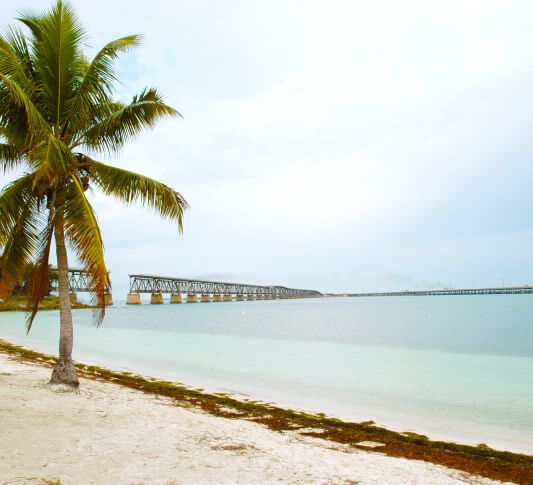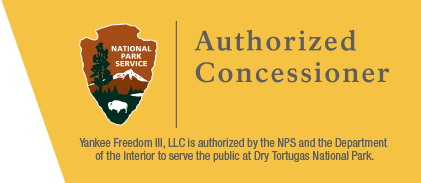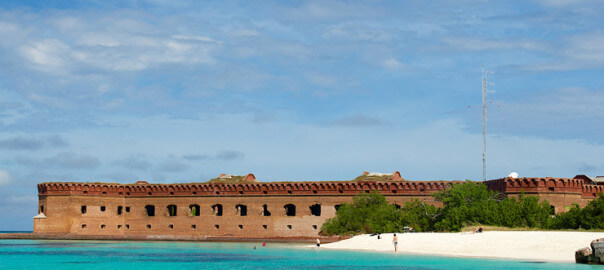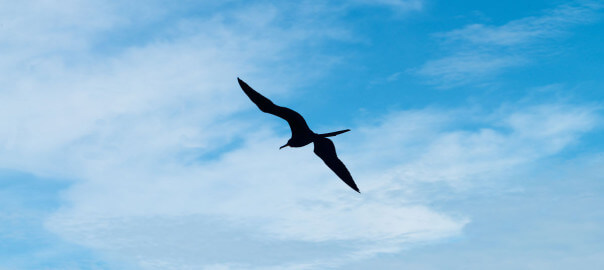Florida State Parks

Estero Bay Preserve State Park
This beautiful house with a whimsical name dates to a quieter time. The Barnacle, built in 1891, offers a glimpse of Old Florida during The Era of the Bay. Situated on the shore of Biscayne Bay, this was the home of Ralph Middleton Munroe, one of Coconut Grove´s most charming and influential pioneers. Munroe’s principal passion was designing yachts. In his lifetime, he drew plans for 56 different boats. As a seaman, civic activist, naturalist, and photographer, Commodore Munroe was a man who cherished the natural world around him. A walk into the park passes through a tropical hardwood hammock. In the 1920s, it was representative of the original landscape within the city of Miami. Today, it is one of the last remnants of the once vast Miami Hammock. Enjoy sitting in the rocking chairs on the spacious porch used as a gathering place or on a bench under a tree for solitude.
Fakahatchee Strand Preserve State Park
Welcome to the Fakahatchee Strand Preserve State Park, “the Amazon of North America.” The Fakahatchee Strand is a linear swamp forest, approximately twenty miles long by five miles wide and oriented from north to south. It has been sculpted by the movement of water for thousands of years and clean fresh water is the key to its existence. Beneath a protective canopy of bald cypress trees flows a slow moving, shallow river or slough that is warmer than the ambient temperature in the winter and cooler in the summer. The buffering effect of the slough and the deeper lakes that punctuate it shield the forest interior from extreme cold temperatures and this fosters a high level of rare and endangered tropical plant species.
The Fakahatchee Strand Preserve State Park hosts a wide array of habitats and forest types from the wetter swamps and prairies to the drier islands of tropical hardwood hammocks and pine rock lands. Its groves of native royal palms are the most abundant in the state and the ecosystem of the Fakahatchee Strand is the only place in the world where bald cypress trees and royal palms share the forest canopy. It is the orchid and bromeliad capital of the continent with 44 native orchids and 14 native bromeliad species. It is a haven for wildlife. Florida panthers still pursue white-tailed deer from the uplands across the wetlands. Florida black bears and Eastern indigo snakes, Everglades minks and diamondback terrapins can still be found here. The resident and migratory bird life is spectacular and attracts many enthusiastic visitors.
Changes on an ecosystem-wide level are predicted to occur within the Fakahatchee Strand over the coming decades as the Comprehensive Everglades Restoration Plan (CERP) is implemented. The restoration of the Prairie Canal which defines the western border of the Preserve is an especially important aspect of CERP. For almost half a century the Prairie Canal has hastened the drainage of water that the native plant and animal communities of the Fakahatchee Strand depend upon. Once the Prairie Canal is completely filled in, the surface water will move across the landscape, draining slowly instead of poring into bigger canals and gushing into the estuaries of the 10,000 Islands. It will recharge groundwater and pass through the natural filtration processes of swamps, prairies, marshes and mangroves before gradually mixing with salt water. It is and will continue to be an important source of fresh water for human and natural communities.
The southern portion of the Fakahatchee Strand Preserve is a part of one of the most productive estuarine ecosystems in the world. Beneath the surface, where fresh water gradually becomes more saline, ideal conditions exist for spawning and the development of the fry of commercially and recreationally important fish species. Rookeries of wading birds color the landscape with dots of white, blue and pink. Canoeists and kayakers enjoy exploring amidst the scenic beauty. Anglers ply the mangrove-hugged backwaters for snook, snapper, tarpon and redfish. West Indian manatees float about in slow motion while American crocodiles carry on their secretive existence, slipping in and out of the of the tannic water to bask in the sun. On the coastal keys of the Ten Thousand Islands, loggerhead and green sea turtles return annually to nest on the same spits of white sand beach from which they themselves once emerged.
In spite of the ecological damage visited upon the Fakahatchee Strand in the past by clear-cut logging, road building and drainage, it has recovered remarkably well and remains a fairly intact and functional natural system. The raised railway beds or trams of the old logging train still crisscross the Fakahatchee Strand and they create a grid of trails, many of which are maintained for hiking. The Big Cypress Bend Boardwalk provides visitors a glimpse into the past as it winds through a stand of primary cypress forest. The Fakahatchee Strand is an ecological gem. It has much to offer and every season presents different opportunities for visitors. Contact the Preserve Office for upcoming activities like guided swamp walks and canoe trips. For Information about Fakahatchee Strand Preserve State Park, please call 239-695-4593.
Fort Foster State Historic Site
Fort Foster State Historic Site is part of Hillsborough River State Park, though located on the East Side of US 301 from the park. Fort Foster is a reconstructed fort from the Second Seminole War. The Fort is located 1800 feet from the parking lot and has no restrooms available. Tours of the fort are offered (weather permitting) on Weekends and an annual Fort Foster Rendezvous with skirmishes is held in February. Special tours for organized groups are available on request, for information contact Hillsborough River State Park at least two weeks in advance.
An interpretive center is located on the West Side of U.S. 301 in Hillsborough River State Park. The interpretive center contains exhibits about the fort, the Seminoles, and the Second Seminole War. Admission to the visitor center is included in the entrance fee to Hillsborough River State Park. For Information about Fort Foster State Historic Site, please call 813-987-6771.
Gamble Plantation Historic State Park
This antebellum mansion was home to Major Robert Gamble and headquarters of an extensive sugar plantation. It is the only surviving plantation house in South Florida. It is believed that Confederate Secretary of State, Judah P. Benjamin, took refuge here after the fall of the Confederacy, until his safe passage to England could be secured. In 1925, the house and 16 acres were saved by the United Daughters of the Confederacy and donated to the state. Today, the mansion is furnished in the style of a successful mid-19th century plantation. Guided tours of the house are given six times a day, Thursday through Monday and there are picnic tables on the grounds. The visitor center is open from 8:00 a.m.-4:30 p.m., Thursday through Monday; it is closed on Thanksgiving Day, Christmas Day, and New Year´s Day. Located in Ellenton on U.S. 301 East. For Information about Gamble Plantation Historic State Park, please call (941) 723-4536.
Gasparilla Island State Park
Separated from the mainland by Charlotte Harbor and Pine Island Sound, this island is part of a chain of Gulf Coast barrier islands. The centerpiece of Gasparilla is the restored Boca Grande Lighthouse built in 1890. Swimming, snorkeling, fishing, and nature study are popular activities. Shelling is particularly good in the winter months. Two picnic areas offer pavilions for shade and scenic views of the surrounding water. The lighthouse is open to the public 10:00 a.m.- 4:00 p.m. daily from November through April. From May through October it is open Monday through Friday. It is closed on these major holidays: New Years Day, Martin Luther King´s Birthday, Easter, Memorial Day, Independence Day, Labor Day, Thanksgiving Day, and Christmas. Visit www.barrierislandparkssociety.org for more information. Located on the south end of Gasparilla Island on the Boca Grande Causeway (private toll) at County Road 775 and Placida. For Information about Gasparilla Island State Park, please call 941-964-0375.
Highlands Hammock State Park
One of Florida´s oldest parks, opening to the public in 1931, this park was established when local citizens came together to promote the hammock as a candidate for national park status. During the Great Depression, just prior to World War II, the Civilian Conservation Corps (CCC) developed additional park facilities and the beginnings of a botanical garden. Many visitors enjoy bicycling the scenic 3-mile loop drive or hiking along the park´s nine trails. An elevated boardwalk traverses an old-growth cypress swamp. For equestrians, there is an 11-mile, day-use trail. Picnicking is another popular activity as are ranger-guided tours of the park. Highlands Hammock offers a full-facility campground, as well as a youth/group tent campground. A full-service restaurant is located on the park grounds. For schedule and catering information, call (863) 385-7025. A recreation hall is available for rental, as are several picnic pavilions. A museum showcasing the history of the CCC is open 9:30 a.m. – 3:30 p.m. Located on County Road 634, four miles west of Sebring. For Information about Highlands Hammock State Park, please call 863-386-6094.
Pages: 1 2 3 4 5 6 7 8 9 10 11 12 13 14 15 16



